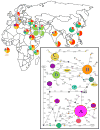Cats of the Pharaohs: Genetic Comparison of Egyptian Cat Mummies to their Feline Contemporaries
- PMID: 22923880
- PMCID: PMC3426309
- DOI: 10.1016/j.jas.2012.05.005
Cats of the Pharaohs: Genetic Comparison of Egyptian Cat Mummies to their Feline Contemporaries
Abstract
The ancient Egyptians mummified an abundance of cats during the Late Period (664 - 332 BC). The overlapping morphology and sizes of developing wildcats and domestic cats confounds the identity of mummified cat species. Genetic analyses should support mummy identification and was conducted on two long bones and a mandible of three cats that were mummified by the ancient Egyptians. The mummy DNA was extracted in a dedicated ancient DNA laboratory at the University of California - Davis, then directly sequencing between 246 and 402 bp of the mtDNA control region from each bone. When compared to a dataset of wildcats (Felis silvestris silvestris, F. s. tristrami, and F. chaus) as well as a previously published worldwide dataset of modern domestic cat samples, including Egypt, the DNA evidence suggests the three mummies represent common contemporary domestic cat mitotypes prevalent in modern Egypt and the Middle East. Divergence estimates date the origin of the mummies' mitotypes to between two and 7.5 thousand years prior to their mummification, likely prior to or during Egyptian Predyanstic and Early Dynastic Periods. These data are the first genetic evidence supporting that the ancient Egyptians used domesticated cats, F. s. catus, for votive mummies, and likely implies cats were domesticated prior to extensive mummification of cats.
Figures


References
-
- Antunes A, Pontius J, Ramos MJ, O’Brien SJ, Johnson WE. Mitochondrial introgressions into the nuclear genome of the domestic cat. Journal of Heredity. 2007;98:414–420. - PubMed
-
- Armitage PL, Clutton-Brock J. A radiological and histological investigation into the mummification of cats from Ancient Egypt. Journal of Archaeological Science. 1981;8:185–196.
-
- Baldwin JA. Notes and Speculations on Domestication of Cat in Egypt. Anthropos. 1975;70:428–448.
-
- Cooper A, Poinar HN. Ancient DNA: Do It Right or Not at All. Science. 2000;289:1139. - PubMed
Grants and funding
LinkOut - more resources
Full Text Sources
Miscellaneous
